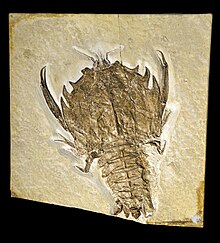| Eryonidae Temporal range: Upper Triassic–Lower Cretaceous PreꞒ Ꞓ O S D C P T J K Pg N | |
|---|---|

| |
| Eryon acrtiformis | |
| Scientific classification | |
| Domain: | Eukaryota |
| Kingdom: | Animalia |
| Phylum: | Arthropoda |
| Class: | Malacostraca |
| Order: | Decapoda |
| Suborder: | Pleocyemata |
| Superfamily: | Eryonoidea |
| Family: | †Eryonidae De Haan, 1841 |
| Genera | |
Eryonidae is a family of fossil decapod crustaceans which lived from the Upper Triassic to the Lower Cretaceous. It contains four genera: An aggregation of three unidentified eryonids was reported in 2012 inside a Late Jurassic ammonoid of the species Harpoceras falciferum; they represent the earliest evidence of gregarious behaviour in decapods.
- Cycleryon Glaessner, 1965
- Eryon A. G. Desmarest, 1817
- Knebelia Van Straelen, 1922
- Rosenfeldia Garassino, Teruzzi & Dalla Vecchia, 1996
References
- Hiroaki Karasawa; Fumio Takahashi; Eiji Doi; Hideo Ishida (2003). "First record of Coleia Broderip (Crustacea, Decapoda, Coleiidae) from the Upper Triassic of Japan". Contributions to Zoology. 72 (2/3): 153–155. doi:10.1163/18759866-0720203017. S2CID 83891436. Archived from the original on 2012-03-28.
- Sammy De Grave; N. Dean Pentcheff; Shane T. Ahyong; et al. (2009). "A classification of living and fossil genera of decapod crustaceans" (PDF). Raffles Bulletin of Zoology. Suppl. 21: 1–109. Archived from the original (PDF) on 2011-06-06.
- Adiël A. Klompmaker; René H. B. Fraaije (2012). "Animal behavior frozen in time: gregarious behavior of Early Jurassic lobsters within an ammonoid body chamber". PLoS ONE. 7 (3): e31893. Bibcode:2012PLoSO...731893K. doi:10.1371/journal.pone.0031893. PMC 3296704. PMID 22412846.
External links
 Media related to Eryonidae at Wikimedia Commons
Media related to Eryonidae at Wikimedia Commons
| Subgroups of order Decapoda | ||
|---|---|---|
| ||
| Dendrobranchiata | ||
| Pleocyemata | ||
| Taxon identifiers | |
|---|---|
| Eryonidae | |
This Decapoda article is a stub. You can help Misplaced Pages by expanding it. |
This article related to a Jurassic animal is a stub. You can help Misplaced Pages by expanding it. |